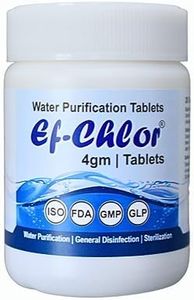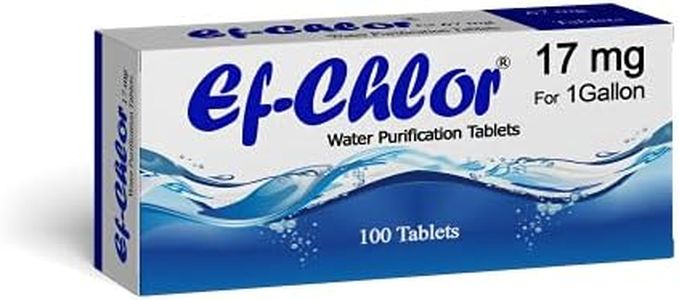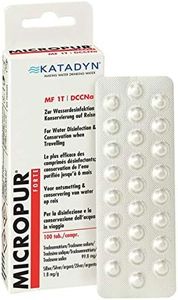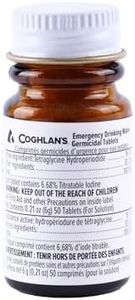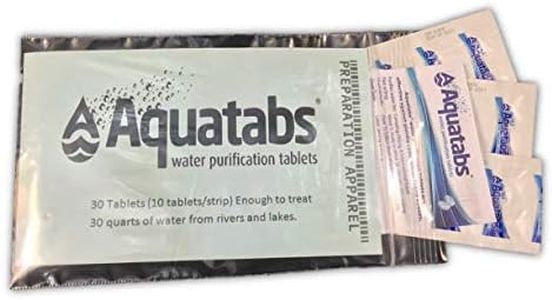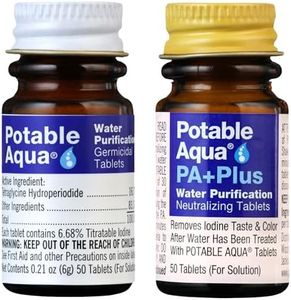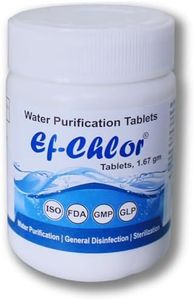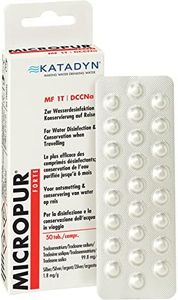We Use CookiesWe use cookies to enhance the security, performance,
functionality and for analytical and promotional activities. By continuing to browse this site you
are agreeing to our privacy policy
10 Best Water Purification Tablets
From leading brands and best sellers available on the web.Buying Guide for the Best Water Purification Tablets
Choosing the right water purification tablets is about making sure you have safe and clean drinking water when you need it most, such as during hiking, camping, travel, or emergencies. Since you might be using these tablets in unfamiliar or challenging conditions, it's important to look for options that not only meet your needs but are easy to use and reliable. Understanding the main specifications will help you pick something that matches your situation and gives you peace of mind about the safety of your water.Active IngredientThe active ingredient in a water purification tablet is the chemical that actually disinfects the water. Common ones include chlorine dioxide, iodine, or sodium dichloroisocyanurate. This is important because different chemicals work in slightly different ways, kill different types of organisms, and can affect the taste and odor of the water. To navigate this, chlorine dioxide tends to be effective against a broad range of contaminants including viruses, bacteria and parasites, and leaves little taste; iodine is also effective but some people dislike the aftertaste and it's not suitable for certain health conditions; sodium dichloroisocyanurate is effective and well-tolerated, often used in large-scale emergencies. Think about whether you have any allergies, if you mind the taste, and if you need to remove tough organisms like Giardia or Cryptosporidium.
Treatment TimeTreatment time is how long you need to wait after adding the tablet before the water is safe to drink. This is important because the waiting period can range from 15 minutes to several hours depending on the type of tablet and the conditions. Faster-acting tablets are convenient when you're on the move or need water quickly, but sometimes a longer time is needed for tough organisms. If you're planning to use the tablets for quick hydration during outdoor activities, look for short treatment times. If you're preparing overnight or for less immediate use, longer times are less of an issue.
Water Volume per TabletThis spec tells you how much water one tablet can purify. It's important because you'll need to know how many tablets to bring based on your water needs. Tablets designed for 1 liter are common, but some are intended for larger or smaller amounts. To pick the right ones, think about how much drinkable water you need in one go and how many people you’re serving. For solo use, 1-liter tablets are convenient, while group or family use may benefit from tablets that treat more at a time.
Shelf LifeShelf life is the length of time the tablets remain effective if they are kept unopened in storage. This matters if you want to keep tablets in an emergency kit or don’t use them often, as expired tablets may not disinfect water properly. Shelf lives vary from a couple of years to up to five years or more. If you're buying for emergency kits or rarely used situations, choose options with a long shelf life. For regular or heavy users, shelf life may be less critical so long as you rotate stock.
Taste and OdorThis spec refers to how much the tablet affects the flavor and smell of your drinking water. Since some chemicals can leave a strong taste or odor, it's important to consider your sensitivity or preferences, especially for children. Chlorine dioxide and sodium-based tablets tend to have less impact on taste, while iodine can leave water with a medicinal flavor. If taste is a concern, look for tablets advertised as having minimal taste or consider additional neutralizer tablets.
Effectiveness SpectrumThe effectiveness spectrum describes which organisms the tablet can protect you from—bacteria, viruses, and parasites (protozoa). Not all tablets protect against all threats, and this is crucial if you’ll be using water from sources that could be contaminated with specific organisms. For example, chlorine dioxide is effective against most bacteria, viruses, and protozoa, while iodine does not kill certain parasites as effectively. Choose a tablet that protects against the pathogens most likely to be found in your water sources.

